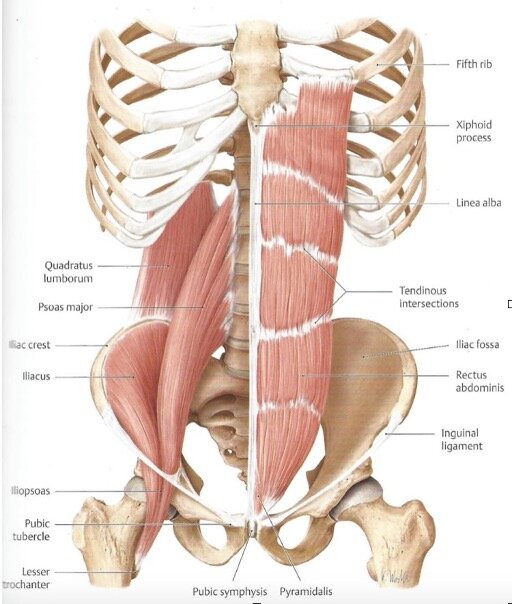By: Reagan Rupard
In addition to back pain, hip flexor discomfort is a common complaint for coaches and clients on the FierceFormer®. The hip flexors are a group of muscles that span the front of the hip and are responsible for bending the hip as you do when you pull your knee in towards your chest. This motion is also happening in a lot of core moves like plank to table top where you move from an extended hip joint in plank to a flexed position in table top, fierce crunch, kneeling crunch, and flying table top, as well as many others.
The problem begins when our brain chooses to use our hip flexors to do the work instead of our abdominal core muscles. The hip flexors are part of our stabilizing “core” that often turn on to do more than their fair share of the work when the body feels overwhelmed by a difficult exercise. Over time, the brain automatically turns on hip flexors in core moves as a sort of muscle memory, and over time our core exercises are primarily hip flexor exercises! If you’re someone who cannot seem to turn off hip flexors during the core blocks, this might be the problem you’re dealing with. Not only are our abdominal core muscles missing out on strengthening opportunities in these exercises when the hip flexors take over to do the work, but this puts our hip flexors at risk for overuse and stress that can cause discomfort during class.
To undo the muscle memory, we’ve programmed our bodies to use, I’ll ask that you give yourself patience, because this will require modifying quite a bit! You’ve got to find the level of challenge in each move that ignites your core, but is not so difficult that your body turns on your hip flexors to help. We can also utilize slight position changes that will tend to turn on our core more than our hip flexors. I’ve outlined three rules you can apply to your workout to, over time, relieve hip flexor overuse in core exercises. Use the photo below for anatomical references to help you build the mind-body awareness that will guide your modifications in class. Though it only shows a superficial layer of the core and doesn’t include the obliques and transversus abdominis (our real focus in Fierce45), the anatomical landmarks apply to those important muscles, too. I’ll be focusing on the most common triggering move: Fierce Crunch.
-
Find your posterior pelvic tilt: belly-up core moves like Fierce Crunch or Bicycle Crunch are typically the most triggering for hip flexor discomfort. Make sure you’re sitting in a posterior pelvic tilt with your tailbone tucked slightly underneath you and your weight back on your sacrum (the flat upside-down triangle in your low back) instead of your sit bones (ischial tuberosities – the bony part of the bottom of your butt). This posture in itself facilitates core activation and decreases hip flexor activation. Not sure what this looks like? Ask your coach next time you take class!
-
Start the crunch with your core: Reference the anatomy photo above. The top of your abdominal core starts at the ribcage and runs down to your pubic bone – the front center of the bottom of your pelvis. Rather than starting a crunch up by pulling your knees in, think about pulling these two parts – ribcage and pubic bone – closer together. You should already be in a posterior pelvic tilt as mentioned in the last point, so from there focus on rounding your torso as much as possible from tailbone all the way up the spine. The result is a slight tailbone tuck at the beginning of full range that ignites your core and inhibits your hip flexors. Also…. SO HARD.
-
Decrease intensity! Our priority in any exercise at Fierce45 should not be getting the biggest range of motion, but rather tapping into that range that challenges the target muscle group. Having the lowest Fierce Crunch or moving through really large ranges in something like plank to tabletop will typically rely on hip flexors to make up the work that the core can’t. So – think small. In a Fierce Crunch, find your Fierce Wrap before you even lean back into the range. As mentioned above, make sure you’re in a posterior pelvic tilt, then lean your torso back until the first moment you feel your core ignite. As you move through full range, go lower as long as you’re able to maintain the Fierce Wrap (no doming!) and stop if you feel any hip flexor discomfort. You can also eliminate the movement of your legs in Fierce Crunch to stay focused on what your core is doing. For many moments of your next several classes, finding the balance between targeting core and not over engaging hip flexors may mean that you just hold! And that is OKAY! You are retraining your body to utilize your abdominal core muscles in a way that will make you stronger on and off the machine and will eventually allow you to take class without hip flexor discomfort. As you build core strength and mind-body awareness of which muscles are working, you can slowly increase this range of motion and, over time, move through a full range using your abdominal core. Though this may seem like a less intense version of this exercise, using only your abdominal muscles makes these exercises SO HARD! I promise you will not be without a challenge.
As always, if you’re experiencing pain or discomfort in Fierce that cannot be managed with modifications or your pain lasts for a significant amount of time after getting off the machine, go visit a physical therapist or your doctor to tackle injuries and get you back on the machine feeling 100%.


